Dongguan
Key Laboratory of Interdisciplinary Science for Advanced Materials and
Large-Scale Scientific Facilities was set up in 2023 upon the approval of
Dongguan Science and Technology Bureau. Relying on the advantages of GBU, the
Laboratory is designed to conduct scientific research, talent cultivation and
industry-university-research cooperation.
The
Laboratory focuses on the cutting-edge interdisciplinary research on advanced
materials and large-scale scientific facilities like China Spallation Neutron
Source, synchrotron radiation source, and advanced attosecond laser facilities.
To address the forefront challenges and industrial pain points in the field of
advanced materials, we strive to combine advanced technologies such as neutron
scattering, synchrotron radiation X-ray optics, and ultrafast attosecond optics
with pioneering research in advanced materials science. The ultimate goal is to
push the frontiers of advanced materials science and drive industrial upgrading
by fully leveraging the strategic location advantages of Dongguan’s large-scale
scientific facilities. The Laboratory’s research is structured around the
following four main directions:
1) Advanced structural
materials and metamaterials: With a focus on high-entropy alloys,
nanostructured metal materials, and materials designed for extreme conditions,
we delve into their microstructural evolution and deformation mechanisms under
extreme environmental conditions.
2) Advanced energy and catalytic
materials: Key researches cover new energy storage materials, photocatalytic
materials, biomimetic catalytic materials, and gas adsorption and separation
materials. Utilizing neutron diffraction and synchrotron radiation, we explore
multi-scale structural control and precise active site analysis. Ultrafast
attosecond laser technology is employed to study the ultrafast electron
dynamics in photocatalytic materials, elucidating the mechanisms of catalysis
and energy storage.
3) Advanced semiconductor
and electronic materials: This direction focuses on the research on
thermoelectric materials, organic semiconductors & electronic materials,
and organic photovoltaic materials & devices. Techniques such as
grazing-incidence small-angle neutron scattering and time-of-flight
quasi-elastic neutron scattering are used to characterize the surface
morphology, coupling mechanisms of micro freedoms, and dynamic behavior of
materials and devices, with the aim of developing high-performance devices.
4) Advanced functional and smart
materials: Functional organic polymer materials, polymer gel biomimetic
materials, and biomedically responsive hydrogels are covered here. Our research
integrates large-scale scientific facilities to study the intrinsic mechanisms
of intelligent stimulus responses to develop high-performance polymers for
biomedical and biomimetic applications.
At
present, the Laboratory is focusing on the initial phase of construction,
spearheading the integration of neutron scattering techniques with advanced
materials research.














